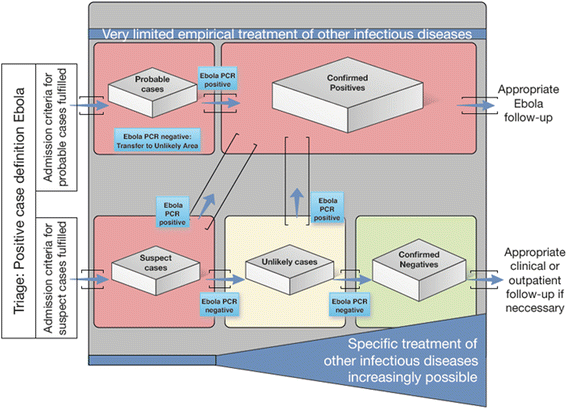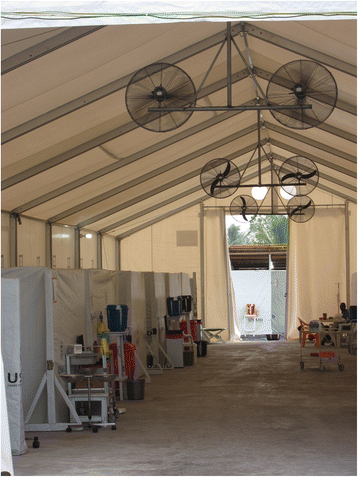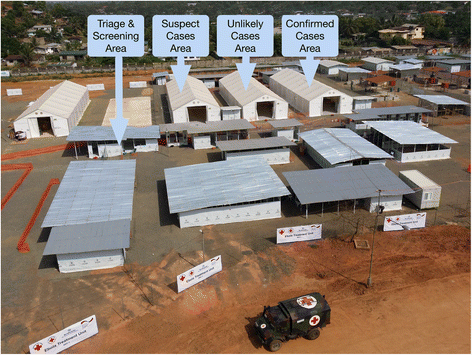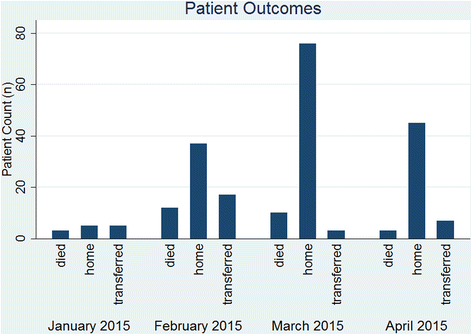Beyond Ebola treatment units: severe infection temporary treatment units as an essential element of Ebola case management during an outbreak
- PMID: 28166739
- PMCID: PMC5295220
- DOI: 10.1186/s12879-017-2235-x
Beyond Ebola treatment units: severe infection temporary treatment units as an essential element of Ebola case management during an outbreak
Abstract
In the course of the Ebola outbreak in West Africa that was witnessed since early 2014, the response mechanisms showed deficits in terms of timeliness, volume and adequacy. The authors were deployed in the Ebola campaign in the West African country Liberia, where by September 2014 the changing epidemiological pattern made reconsiderations of guidelines and adopted procedures necessary. A temporary facility set up as a conventional Ebola Treatment Unit in the Liberian capital Monrovia was re-dedicated into a Severe Infections Temporary Treatment Unit. This facility allowed for stratification based on the nosocomial risk of exposure to Ebola virus for a growing subgroup of admitted patients that in the end would turn out as Ebola negative cases. At the same time, adequate diagnostic measures and treatment for the non-Ebola conditions of these patients could be provided without compromising work safety of the employed staff. The key elements of the new unit comprised a Suspect Cases Area similar to that of conventional Ebola treatment units for newly arriving patients, an Unlikely Cases Area for patients with a first negative Ebola PCR result, and a Confirmed Negative Cases Area for patients in whom Ebola could be ruled out. The authors, comprising representatives of the Liberian Ministry of Health and Social Welfare, as well as infectious disease specialists from the German Ebola Task Force are presenting key features of the adapted concept, and are highlighting its relevance in raising acceptance for outbreak counter-measures within the population at stake.
Keywords: Case management; Ebola; Ebola treatment unit; Epidemiology; Infectious disease unit; Isolation; Liberia; Nosocomial infection; SITTU; Severe infections teamporary treatment unit.
Figures






References
-
- World Health Organization. Interim infection prevention and control guidance for care of patients with suspected or confirmed filovirus haemorrhagic fever in health-care settings, with focus on Ebola. WHO Publications: WHO/HIS/SDS/2014.4. September 2014.
-
- Kucharski AJ, Camacho A, Checchi F, Waldman R, Grais RF, Cabrol JC, Briand S, Baguelin M, Flasche S, Funk S, Edmunds WJ. Evaluation of the benefits and risks of introducing Ebola community care centers, Sierra Leone. Emerg Infect Dis. 2015;21(3):393–399. doi: 10.3201/eid2103.141892. - DOI - PMC - PubMed
-
- ProMED-mail. Ebola virus disease - West Africa (87): Liberia, Sierra Leone, MSF, drugs, vaccine. ProMED-mail 2014. Published Date: 2014-07-12 22:00:12. Archive Number: 20140712.2605570. http://www.promedmail.org. Accessed 20 July 2016
-
- Liberian Ministry of Health and Social Welfare. Liberia Ebola Daily Sitrep no. 193 for 24th November 2014. https://www.humanitarianresponse.info/en/operations/liberia/document/lib.... Accessed 2 Feb 2017.
-
- World Health Organization. Ebola Situation Report 18 March 2015. http://apps.who.int/ebola/current-situation/ebola-situation-report-18-ma.... Accessed 20 Aug 2015.
Publication types
MeSH terms
Substances
LinkOut - more resources
Full Text Sources
Other Literature Sources
Medical

